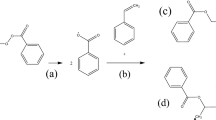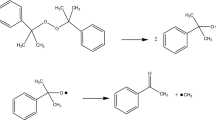Abstract
Liquid organic peroxides have been broadly employed in the process industries such as tert-butyl peroxy-2-ethyl hexanoate (TBPO). This study investigated the thermokinetic parameters of TBPO, a typical liquid organic peroxide, by isothermal kinetic algorithms and non-isothermal kinetic algorithms with thermal activity monitor III, and differential scanning calorimetry, respectively. An attempt has been made to determine the thermokinetic parameters by simulation software, such as exothermic onset temperature (T 0), maximum temperature (T max), decomposition (∆H d), activation energy (E a), self-accelerating decomposition temperature, and isothermal time to maximum rate (TMRiso). A liquid thermal explosion model was established for a reactor containing liquid organic peroxide of interest. From experimental results, liquid organic peroxides’ optimal conditions for avoiding a violent runaway reaction of storage and transportation were created.







Similar content being viewed by others
Abbreviations
- A :
-
Frequency factor (s−1)
- C p :
-
Heat capacity (J g−1 K−1)
- E a :
-
Activation energy (kJ mol−1)
- k :
-
Thermal conductivity (W m−1 K−1)
- k 0 :
-
Reaction rate constant (min−1)
- k i :
-
Reaction rate constant at isothermal temperature (min−1, i = 0, 1, 2, 3)
- n i :
-
Reaction order of ith stage (dimensionless)
- Q max :
-
Maximum heat flow (W g−1)
- SADT:
-
Self-accelerating decomposition temperature (°C)
- T :
-
Absolute temperature (K)
- T 0 :
-
Exothermic onset temperature (°C)
- T e :
-
Ambient temperature (°C)
- T f :
-
Final temperature (°C)
- T iso :
-
Isothermal temperature (°C)
- T P :
-
Peak temperature (°C)
- TMRiso :
-
Time to maximum rate under isothermal condition (h)
- t :
-
Time (s)
- Z :
-
Autocatalytic constant (dimensionless)
- α i :
-
Degree of conversion (dimensionless)
- β:
-
Heating rate (°C min−1)
- ∆H d :
-
Heat of decomposition (J g−1)
References
Lu KT, Chen TC, Hu KH. Investigation of the decomposition reaction and dust explosion characteristics of crystalline benzoyl peroxides. J Hazard Mater. 2010;161:246–56.
Luo KM, Chang JG, Lin SH, Chang CT, Yeh TF, Hu KH, Kao CS. The criterion of critical runaway and stable temperatures in cumene hydroperoxide reaction. J Loss Prev Proc Ind. 2001;14:229–39.
United Nations, Committee of Experts on the Transport of Dangerous Goods, 14th Revised Ed., USA. 2005;205.
Fisher HG, Goetz DD. Determination of self–accelerating decomposition temperatures for self–reactive substances. J Loss Prev Proc Ind. 1993;6:183–94.
Fauske HK. Gassy system vent sizing the role of two-phase flow. Process Safety News. Burr Bidge, IL: Fauske and Associates, LLC; 2011;18:3.
AKTS AG, AKTS–Thermokinetics Software and AKTS–Thermal Safety Software. http://www.akts.com.
Material Safety Data Sheet. Akzo Nobel Chemicals bv Stationsplein, 4. P.O. Box 247, 3800 AE Amersfoort, The Netherlands; 2007.
Wu LK, Chen KY, Cheng SY, Lee BS, Shu CM. Thermal decomposition of hydrogen peroxide in the presence of sulfuric acid. J Therm Anal Calorim. 2008;93:115–20.
Hou HY, Duh YS, Lin WH, Shu CM. Reactive incompatibility of cumene hydroperoxide mixed with alkaline solutions. J Therm Anal Calorim. 2006;85:145–50.
Duh YS, Wu XH, Kao CS. Hazard ratings for organic peroxides. Process Saf Prog. 2008;27:89–99.
Safety and handling of organic peroxides: a guide, organic peroxide producers’ safety division. The Society of the Plastics Industry (SPI) Inc., Washington, DC, USA. 1999.
Lin CP, Chang CP, Chou YC, Shu CM. Modeling solid thermal explosion containment on reactor HNIW and HMX. J Hazard Mater. 2010;176:549–58.
STARe Software with Solaris Operating System. Operating Instructions. Toledo: Mettler Toledo; 2004.
Product Information. 2012. TAM III Thermostat. www.thermometric.com.
Lin CP, Chang YM, Tseng JM, Shu CM. Comparisons of nth-order kinetic algorithms and kinetic model simulation on HMX by DSC tests. J Therm Anal Calorim. 2010;100:607–14.
Thermal safety software (TSS). St. Petersburg, Russia: ChemInform Saint-Petersburg (CISP) Ltd. http://www.cisp.spb.ru.
You ML, Shu CM. Further explanations of lauroyl peroxide runaway reaction by DSC tests and simulations. J Therm Anal Calorim. 2011;103:411–2.
Lin CP, Tseng JM. Green technology for improving process manufacturing design and storage management of organic peroxide. Chem Eng J. 2012;180:284–92.
Peng JJ, Wu SH, Hou HY, Lin CP, Shu CM. Thermal hazards evaluation of cumene hydroperoxide mixed with its derivatives. J Therm Anal Calorim. 2009;96:783–7.
Liu SH, Lin CP, Shu CM. Thermokinetic parameters and thermal hazard evaluation for three organic peroxides by DSC and TAM III. J Therm Anal Calorim. 2011;106:165–72.
Tseng JM, Liu MY, Chen SL, Hwang WT, Gupta JP, Shu CM. Runaway effects of nitric acid on methyl ethyl ketone peroxide by TAM III tests. J Therm Anal Calorim. 2009;96:789–93.
Akzo Nobel, Organic Peroxide Initiators, Product Brochure, USA. 2012.
Malow M, Wehrstedt KD. Prediction of the self–accelerating decomposition temperature (SADT) for liquid organic peroxides from differential scanning calorimetry (DSC) measurements. J Hazard Mater. 2005;120:21–4.
Lin CP, Tseng JM, Chang YM, Liu SH, Cheng YC, Shu CM. Modeling liquid thermal explosion reactor containing tert–butyl peroxybenzoate. J Therm Anal Calorim. 2010;102:587–95.
Acknowledgements
The authors are indebted to Dr. J. M. Tseng for their technical assistance on this study.
Author information
Authors and Affiliations
Corresponding author
Rights and permissions
About this article
Cite this article
Tsai, LC., Tsai, YT., Lin, CP. et al. Isothermal versus non-isothermal calorimetric technique to evaluate thermokinetic parameters and thermal hazard of tert-butyl peroxy-2-ethyl hexanoate. J Therm Anal Calorim 109, 1291–1296 (2012). https://doi.org/10.1007/s10973-012-2519-8
Published:
Issue Date:
DOI: https://doi.org/10.1007/s10973-012-2519-8




